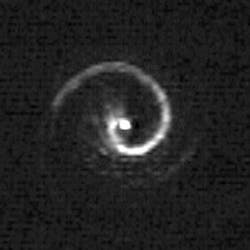Phase functions are inseparable in helico-conical optical beams
Most optical vortices, or light beams with phase singularities, have a vanishing field at the singularity location, resulting in a doughnut- or ring-shaped intensity cross section. Strongly focused optical vortices, used for trapping of particles, also impart an orbital angular momentum to the trapped particles and are potentially useful in the development of optical microfluidic and micromanipulation systems.
Optical vortices are typically described as Laguerre-Gaussian beams featuring helical phase fronts or higher-order Bessel beams with phase fronts appearing as the sum of helical conical functions. In either case, the phase can be considered to have separable radial and azimuthal dependence. But scientists from the National Institute of Physics at the University of the Philippines (Quezon City, Philippines) and the Optics and Plasma Research Department of the Risø National Laboratory (Roskilde, Denmark) have created a novel helico-conical optical beam that is the product of helical and conical phase terms leading to a nonseparable radial and azimuthal dependence and a phase that is not entirely continuous.1
Created by spatial light modulator
To generate the helico-conical beams, a 30-mW HeNe laser is expanded to about 24 mm in diameter. While controlling the intensity with a half-wave plate and polarizer, the expanded beam is passed through a beam splitter onto the 20 × 20-mm face of a reflection-type spatial light modulator. An adjustable circular aperture stop with a maximum diameter of 11 mm is placed in front of the spatial-light-modulator surface, with the beamsplitter directing reflected light from the modulator through a lens and neutral-density filter toward a CCD camera. The CCD images are captured by a personal computer through a peripheral-component-interface/video-capture card.
Representing the phase function ψ of the helico-conical beam as:
ψ (r, θ) = lθ(K - r/r0)
where l is an integer that determines the number of 2π phase shifts that occur across one revolution of the azimuthal angle θ, r0 is a normalization factor of the radial coordinate r, and K is a constant that takes a value of either 1 or 0, phase masks can be developed by using the K values of 1 and 0 and choosing r0 to coincide with the radius of the circular aperture stop placed in front of the spatial light modulator. The corresponding 2-D phase profiles from the phase masks show mixed helical and conical features.
The intensity at the CCD sensor can be both mathematically computed and physically recorded as an arithmetic spiral of points (see figure). Depending upon the value of K, the intensity distribution varies as a function of radial dependence. When the scientists studied the three-dimensional intensity distribution near the focal plane, they found that the intensity profile rotates as the beam propagates, and appears to reverse in handedness as it evolves in the region prior to the focal plane. Propagation beyond the lens focus is characterized by a dilation of the intensity distribution, remaining nearly invariant in structure. Propagation toward the focal plane is particularly interesting in the case of K = 0, where the projected intensity distribution forms an intensity hot spot that follows a corkscrew path around the propagation axis.The researchers see this optical vortex as being unique: as well as being able to simply trap particles, its helico-conical shape could be used for rotational positioning of asymmetric particles, or even for the collection and accumulation of smaller particles toward the focal point. Senior scientist Jesper Glückstad from Risø, who came up with the idea of the helico-conical beams, notes that the next steps in this research would include implementing the helico-conical beams in an optical-trapping laser system with higher power to observe the behavior of microparticles under the influence of these beams.
Glückstad also suggests continued exploration into the basic propagation dynamics in further search of interesting properties of helico-conical beams. “The radically different beam profile we have observed shows that there is a wealth of interesting results to be explored in the nonlinear combination of phase functions,” he says. “More than that, our work demonstrates the flexibility provided by digitally addressed spatial light modulators. These devices empower researchers to think outside the box and easily conjure up beam profiles unattainable with conventional optics.”
REFERENCE
1. C. A. Alonzo et al., Optics Express 13(5) 1749 (March 7, 2005).
About the Author

Gail Overton
Senior Editor (2004-2020)
Gail has more than 30 years of engineering, marketing, product management, and editorial experience in the photonics and optical communications industry. Before joining the staff at Laser Focus World in 2004, she held many product management and product marketing roles in the fiber-optics industry, most notably at Hughes (El Segundo, CA), GTE Labs (Waltham, MA), Corning (Corning, NY), Photon Kinetics (Beaverton, OR), and Newport Corporation (Irvine, CA). During her marketing career, Gail published articles in WDM Solutions and Sensors magazine and traveled internationally to conduct product and sales training. Gail received her BS degree in physics, with an emphasis in optics, from San Diego State University in San Diego, CA in May 1986.

